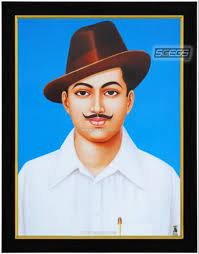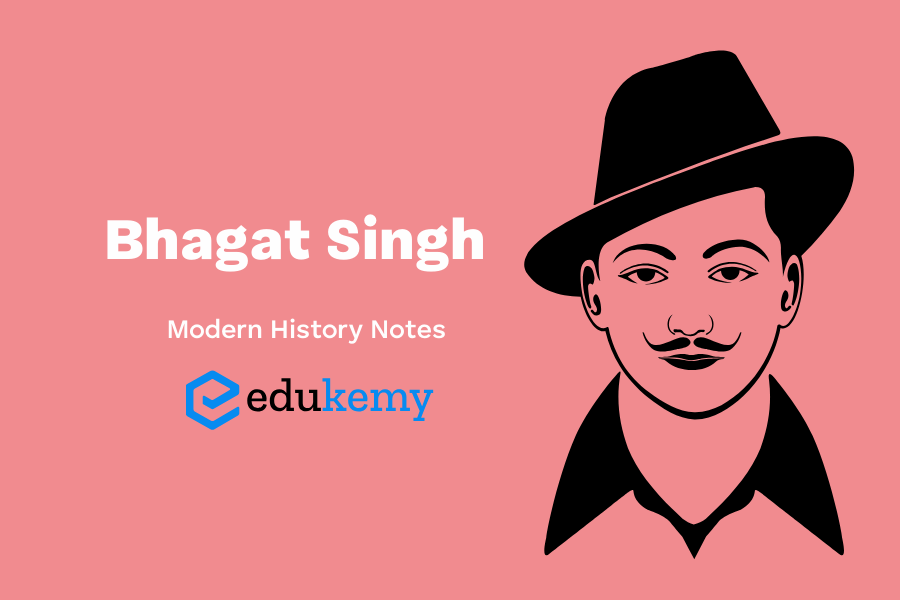Bhagat Singh, an iconic figure in the annals of modern Indian history, stands as a symbol of unwavering courage, patriotism, and sacrifice. Born on September 28, 1907, in Banga, British India, Singh emerged as a prominent revolutionary during the tumultuous era of the Indian independence movement. His profound commitment to the cause of a free and sovereign India led him to embrace radical ideologies and employ daring methods to challenge British colonial rule. Bhagat Singh’s life was tragically cut short at the age of 23, but his indomitable spirit and fearless actions continue to inspire generations, leaving an indelible mark on the narrative of India’s struggle for independence. This modern history note seeks to unravel the compelling story of Bhagat Singh, a fearless revolutionary whose legacy reverberates through the pages of India’s fight for freedom.
Contents
- 1 Life of Bhagat Singh
- 2 Foundation of Naujawan Bharat Sabha (NBS – 1926)
- 3 FAQs
- 3.1 Q1: Where can I find a photo of Bhagat Singh?
- 3.2 Q2: When is Bhagat Singh’s birthday?
- 3.3 Q3: Is there a university named after Bhagat Singh?
- 3.4 Q4: Are there any artistic drawings related to Bhagat Singh available online?
- 3.5 Q5: Can I find images of Bhagat Singh online?
- 3.6 Q6: Where can I find the authentic photo of Bhagat Singh?
- 3.7 Q7: Who is Bhagat Singh Koshyari?
- 4 In case you still have your doubts, contact us on 9811333901.
Life of Bhagat Singh
- Born in 1907 in a patriotic family, son of a Congressman & nephew of famous revolutionary Ajit Singh.
- Was deeply influenced by Ghadar’s hero, Kartar Singh Sarabha.
- Was a voracious reader and had read extensive literature on Socialism, the Soviet Union, and revolutionary movements the world over. At Lahore, he and Sukhdev organized study circles for young students (This devotion to intensive reading was also true of other leaders such as Bejoy Sinha, Yashpal, Shiv Varma, and Bhagwati Charan Vohra. Chandrashekhar Azad knew little English, but he too fully participated in political discussions and followed all major turns in the field of ideas).
Foundation of Naujawan Bharat Sabha (NBS – 1926)
- Already before his arrest in 1929, he had abandoned his faith in terrorism & individual heroic action. He had come to believe that broad popular mass movements alone could liberate India & mankind from servitude
- For this, he made NBS in 1926 to carry out political work among youth, peasants &’ workers
- Bhagat Singh never identified revolution with the cult of the bomb. This was the only reason they threw a relatively harmless bomb in the Central Legislative Assembly in 1929. Their strategy was to get arrested and then turn the courts into arenas for the propagation of their ideas.
He changed the meaning & method of revolution
- Method: revolution can be achieved by arousing the masses and organizing a mass movement. Just before his execution, Bhagat Singh declared that “the real revolutionary armies are in the villages and factories“.
- Meaning: Revolution was no longer equated with mere militancy or violence. Its first objective was national liberation and then the building of a new socialist society (a society in which there is no exploitation of man by man & of nation by nation )
- Philosophy of Bomb (written by BC Vohra, Azad & Yashpal) also favored the above definition of revolution
It meant the abolition of capitalism & class domination. He fully accepted Marxism & class approach to society
- Bhagat Singh was the first leader who understood the full dangers of communalism. According to him, Communalism was big danger than colonialism & even criticized Lala Lajpat Rai when he took communal politics after 1924. People must free themselves from the mental bondage of religion & consider religion as a matter of personal belief of man. He wrote Why am an Atheist in which he said any man who stands for progress has to challenge every item of old faith.
- His relevance in present times: Communalism, student politics, inequality, scientific approach.
FAQs
Q1: Where can I find a photo of Bhagat Singh?
A1: You can find photos of Bhagat Singh online by searching on various websites or using image search engines.

Q2: When is Bhagat Singh’s birthday?
A2: Bhagat Singh’s birthday is on September 28, 1907.
Q3: Is there a university named after Bhagat Singh?
A3: Bhagat Singh University may refer to a fictional or specific university. It’s recommended to provide more context for accurate information.
A4: Yes, you can find artistic drawings and illustrations related to Bhagat Singh by searching online or on art-related websites.
Q5: Can I find images of Bhagat Singh online?
A5: Yes, you can find various images of Bhagat Singh by searching online or using image search engines.
Q6: Where can I find the authentic photo of Bhagat Singh?
A6: Authentic photos of Bhagat Singh can be found in historical archives, books, and online sources that provide reliable historical information.
Q7: Who is Bhagat Singh Koshyari?
A7: Bhagat Singh Koshyari may refer to a specific individual, but without more context, it’s difficult to provide specific information. Please provide additional details for a more accurate answer.
In case you still have your doubts, contact us on 9811333901.
For UPSC Prelims Resources, Click here
For Daily Updates and Study Material:
Join our Telegram Channel – Edukemy for IAS
- 1. Learn through Videos – here
- 2. Be Exam Ready by Practicing Daily MCQs – here
- 3. Daily Newsletter – Get all your Current Affairs Covered – here
- 4. Mains Answer Writing Practice – here

